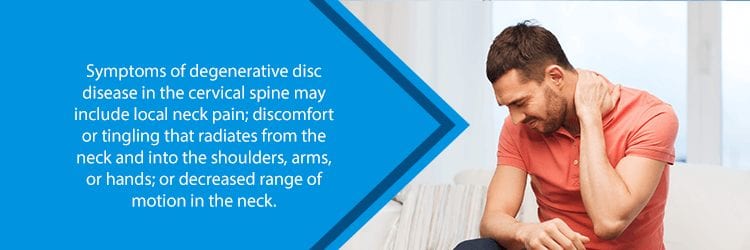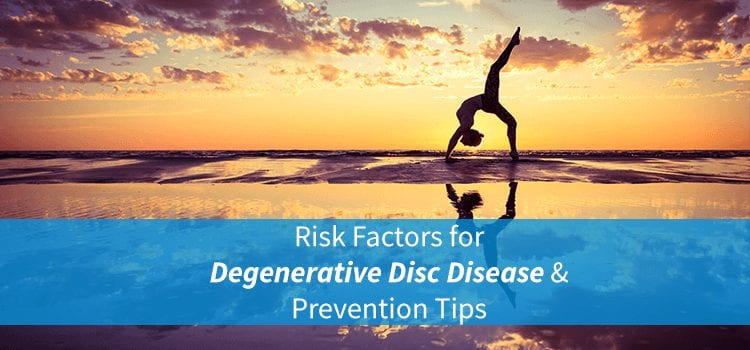The spine plays a key role in supporting and protecting our bodies. Unfortunately, like the rest of our body, it suffers from wear and tear. This is especially true for the spinal discs.
Between each spinal vertebrae rests a protective disc. These intervertebral discs act shock absorbers and protect the spinal cord. They also contribute to the spine’s movement and flexibility.
Spinal discs have two main parts. The inner layer (or nucleus pulposus) contains a gel-like fluid that helps to absorb shock. The outer layer (or annulus fibrosus) surrounds the nucleus pulposus. It is made of a strong, fibrous cartilage that gives structure to the disc. A healthy annulus fibrosus keeps the inner layer from leaking out of the disc. It also distributes pressure during the body’s movements.
As we get older, these discs tend to get weaker and damaged, a process known as disc degeneration.

What is Degenerative Disc Disease?
Degenerative disc disease involves the natural wear and tear of intervertebral discs. It occurs most commonly in the neck or lower back. As we age, the cartilage in these discs starts to degrade. This causes their water and protein content to decrease. As the discs start to shrink, the reduced space between the vertebrae can cause pain and other symptoms.
The shrinking of the disc causes instability in the surrounding muscles, ligaments, and joints. Time is needed for the spine to adjust to the damaged disc. The adjustment period usually involves low to moderate discomfort with occasional flare-ups of more intense pain. In time, the area of the spine begins to stabilize and symptoms decrease.
Symptoms of Degenerative Disc Disease
Symptoms of this condition vary depending on the location and severity of the damaged disc. Some with this condition may not experience any symptoms. Others may have severe pain as well as neurological issues. Symptoms often occur when there is instability in the spine, irritation of a nerve root, or muscle tension in the area.
Common symptoms include:
- Continuous pain in the affected area
- Occasional, more intense “flare-ups” of pain that last several days or weeks
- Muscle pain or spasms
- Sharp, stabbing, or radiating pain
- Reduced pain when changing positions
Symptoms for degenerative disc disease in the neck include:
- Neck stiffness
- Pain in the neck that radiates to the arms and hands
- Decreased range of motion in the neck
- Numbness and tingling in the fingers and hands
- Increased pain while looking down for too long

Symptoms for degenerative disc disease in the lower back include:
- Pain in the low back, thighs, or buttocks
- Tenderness in the back
- Pain that worsens when sitting and lessens when walking or moving
- Discomfort when lifting, bending, or twisting
- Feeling a sudden instability or weakness in the back during quick movements
- Weakness in leg muscles
Other concerns related to degenerative disc disease include:
- Painful inflammation may develop when the proteins of the disc come into contact with other nearby spinal structures.
- Disc degeneration can lead to spinal stenosis, osteoarthritis, and pinched nerves.
- A damaged disc is more prone to bulging or herniation, which may put pressure on the spinal cord or nerve roots.
7 Risk Factors for Degenerative Disc Disease
By understanding some of the risk factors, you may be able to slow down the degenerative process.
- Aging: Degenerating discs are a natural part of the aging process. In time, we all experience various levels of disc degeneration.
- Family History & Genetics: Those who have parents or other family members with back pain or degenerative disc disease have a significantly higher chance of developing this condition.
- Smoking: The nicotine and other dangerous chemicals in tobacco smoke keep the discs from absorbing essential nutrients from the blood. This can dry out the discs and even increase the chances for a herniated disc—when the inner layer breaks through the outer layer of the disc.
- Sedentary Lifestyle: Inactive individuals tend to have more back pain. Prolonged sitting can put a strain on the lower back and spinal discs. In addition, a weak core—abdominal and lower back muscles—gives the spine less support.
- Obesity: Extra body weight often places stress on the spine, back, and pelvis, thus triggering back pain. Moreover, added weight shifts the pelvis forward causing the spine to curve unnaturally. This added strain and awkward posture can damage the discs.
- Occupations & Leisure Activities: Careers that involve heavy manual labor such as lifting and pulling can wear down the discs. In addition, damaged discs are common for those who participate in sports where there is heavy stress on the spine. These activities include running, football, hockey, and wrestling. Repeated impacts to the spine can cause an annular tear—damage to the disc’s outer layer—which hastens the degenerative process.
- Traumatic Injury: Once a disc is injured due to a fall, impact, or accident, the blood supply leading to the disc is often compromised. This slows the delivery of essential nutrients and oxygen to the damaged tissues. Injuries can cause a disc to wear down relatively quickly.

How Can You Prevent Degenerative Disc Disease?
While there are some factors that you can’t control like genetics and age, there are some things you can do to protect and preserve your discs. One of the biggest changes you could make is to quit smoking. Aside from genetics and age, this is one of the major factors that contributes to degenerative disc disease.
In addition, living a healthy lifestyle can positively affect the spine. Good eating habits, including consuming plenty of fruits and vegetables, supplies the body—and your discs—with necessary nutrients. Also, you can avoid processed or junk funds, which tend to encourage inflammation.
Since your spine relies on the support of healthy muscles and soft tissues, make sure that you set time aside for exercise. This helps to strengthen important muscle groups, giving the spine support and flexibility. Consider trying a yoga or pilates routine for better core strength and spinal stability.
If your job or leisure pursuits involve activities that put excess stress on the spine, make sure you use the proper safety equipment and movement techniques. If you experience neck or back pain, consult with a physical therapist or sports medicine professional to receive insights about how you can protect your spine.

Seeking Treatment Can Help Reduce Symptoms
If the pain of degenerative disc disease is keeping you from the life you want to live, you may want to schedule an appointment with an orthopedic doctor. He or she can assess your condition and determine the best treatments for pain management and spine health.
Our spine experts at NJ Spine & Orthopedic will take a free look at any previous MRIs and listen to your concerns about pain. Our dedicated team will find the most appropriate treatments to help get your life back. If you require surgery, our minimally invasive techniques will reduce your pain and shorten your recovery times. This will help you get back to the life you want to live. For more information about degenerative disc disease, schedule an appointment today!

